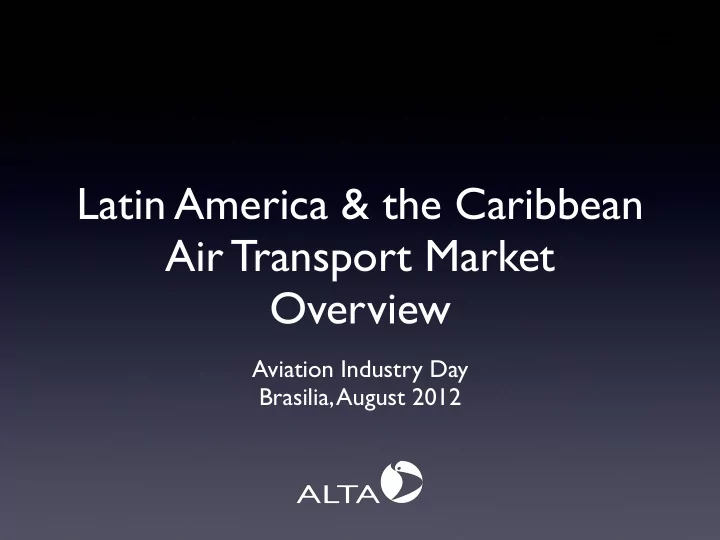

Latin America & the Caribbean Air Transport Market Overview Aviation Industry Day Brasilia, August 2012
Increasing relevance and potential
x2 GDP growth rate doubled in the last decades Source: IMF
x6 Foreign trade volume multiplied by 6 over the last two decades Source: CEPAL
x11 Foreign direct investment increased 11 times since 1990 Source: CEPAL
Inflation under control 7% inflation rate vs. average rates of over 100% in the 80’s and 90’s Source: IMF
-25% Reduction in poverty rates Source: CEPAL
High Traffic Growth Source: ALTA, IATA, AACO (Middle East), AAPA (Asia-Pacific), AEA (Europe), US DOT (US), CAAC (China) *China: from 2005 to 2010. Asia Pacific: international traffic only
Bullish Long-Term Forecasts * Domestic Source: Boeing
In Perspective LATAM USA Europe Fuente: IMF, US Census Bureau, OAG
Capacity by Country of Departure Others 23% Brazil 36% Panama 2% Peru 5% Chile 5% Colombia 5% Argentina Mexico 16% 8% Source: OAG, 2011 *ASK (Available Seat Kilometers)
LCC Penetration Legacy LCC's 53.9% 57.9% Brazil Mexico Source: ANAC Brasil, DGAC Mexico
International Capacity LatAm-USA Traffic LatAm-Europe Traffic Latam Airlines Latam Airlines 20% 23% USA Airlines European Airlines 77% 80% Source: ALTA, AEA, US DOT
The region keeps improving...
...and so does the industry
Younger Fleet Europe USA LATAM ALTA Source: Ascend (jets and turboprops with over 40 seats)
47 Billion Aircraft orders value in 2006-2011 Source: Ascend
LatAm Jet Fleet by Generation 20% 71% 28% 52% 16% 13% Older Mid Newer Source: Boeing
-48% Fewer emissions per passenger km. Source: ALTA airlines
Safety
Constantly Improving Safety North America LATAM ALTA Members Source: IATA. Note: 2011 values estimated assuming no more hull-losses until end of the year
Seamless experience through alliances and consolidation
Alliance Membership In Global Alliances Non-Aligned Source: OAG Note: 2011 figures include announcements that will be made effective in 2012
Consolidation Top 5 Groups Other Carriers Source: OAG
-45% Decrease of average domestic fare in Brazil (adjusted for inflation) Source: ANAC
Will Governments keep pace with Industry’s efforts ?
• Safety • Infrastructure • Competitiveness
Safety Main Issue • Unstabilized approaches and runway excursions
Safety Initiatives • Multi-angle strategy to reduce unstabilized approaches • RASG-PA (ICAO/ANAC/IATA/ALTA) • Best Practices & Information Sharing Programs
Call to Action • Doubling of joint efforts to reduce runway excursions • Adopt new technologies (PBN, etc.) • Promote IOSA as a standard in the region • Information sharing protection • Standardization of phraseology
Infrastructure
USD 4B In fees and charges
66% Not reinvested
> 30% Of flights depart from congested airports
Congested Airports Highly Congested Congested One of every three flights in the region departs from a congested airport
Quality of Air Transport Infrastructure Ranking 2007 Ranking 2011 Argentina 84 115 Brazil 57 93 Colombia 53 89 Costa Rica 68 80 Ecuador 71 73 El Salvador 25 33 Mexico 55 65 Source: World Economic Forum
Call to Action • Reinvest in infrastructure for the industry • Don’t use airport privatizations as cash cows...but as great opportunities to improve efficiencies • Promote integration of ATC in the region
Competitiveness
-43% Decrease of airline unit costs in real terms since 1980 Source: ICAO
5.4 million Jobs generated by the industry in the region Fuente: ATAG, 2012
USD 125B Contribution to the region’s GDP Fuente: ATAG, 2012
Unreasonably High Fuel Costs Source: ALTA
USD 1,000,000 Per aircraft operating the Sao Paulo-Rio de Janeiro route Source: ALTA
High Airport Charges, Monopolistic Earnings Source: Annual Reports (2009)
Restrictions on Foreign Capital Airlines Other industries Establish ✘ ✔ subsidiaries in other counties Sell controlling ✘ ✔ stake to nationals of other countries
Call to Action • Regulate your natural monopolies so they're efficient, not to harvest the most money from them at the expense of your own economies • Eliminate restrictions to foreign capital • Do not tax us as if were a vice or luxury item instead of an engine of development
Conclusions • Air transport is an engine of development • Highly competitive industry with reduced margins • Requirements of significant long-term investments
Conclusions • Airlines cost structures affected by regulatory aspects and monopolist/ oligopolist providers • Need to work together to improve competitiveness to ensure healthy development of the industry
Thank you
Recommend
More recommend